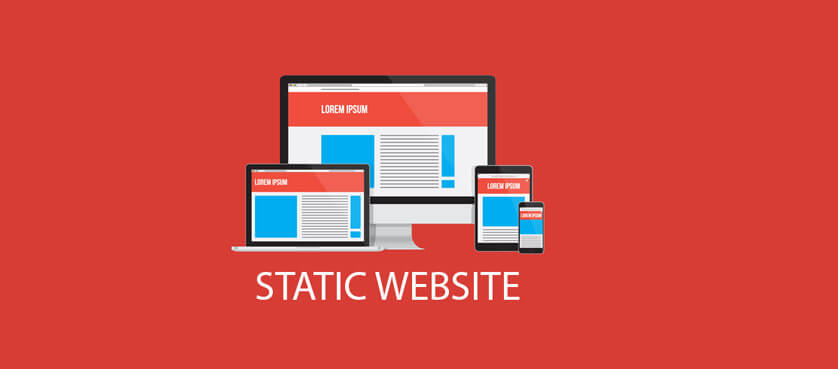Static website design
A static website design is created from a fixed number of pre-designed files stored on the web server. These files are written in HTML, CSS, and JavaScript, called client-side or user-side languages, because they run in the user’s web browser. When a user requests a page using a URL, the server returns the corresponding HTML file specified by the URL and any associated CSS or JavaScript files.
During this exchange, the web server does not modify the files before they are sent to the user, so the web page looks the same to anyone who requests it. This means that the content is “static,” and the only way to change the website’s appearance is to change the content of the files manually. That doesn’t mean static websites can’t be interactive or engaging.
They can still have clickable links and buttons, images and videos, calls to action, forms, digital downloads, and even animations supported by CSS or JavaScript. With enough skill, you can even design a static website beautifully. But, in the end, a static site is always displayed the same way for all users, requiring manual content changes.
Common examples of static site design include resume websites, brochure websites, portfolio sites, and other news sites or blogs. These websites are often small, limited in content, and do not require personalized content or frequent updates.

Advantages of static websites
The advantages of static websites mostly come from their simplicity. Static sites are the easiest type of website to design and support. Static sites are the best option for setting up a basic website quickly and with the lowest website design cost. With knowledge of HTML and CSS, you can design a proper website without much effort and expense.
Static sites usually load pages faster than dynamic sites. This is because pages on static sites are built by default and do not need to be processed during user requests. This increases the actual loading speed of web pages and improves the user experience. Also, static websites are easy to cache because of the lack of variety in content. Website speed, or performance, is critical to a positive user experience and impacts search engine rankings.
Also, static sites are less affected by security attacks due to their simple structure and the lack of need for server-side processing. This means reducing the risk and increasing the safety of the site. With a dynamic site, hackers have multiple opportunities to infiltrate your data. However, in a static site, the database is independent of the site’s graphical user interface.
Disadvantages of static websites
As you can guess, a static site is often not the best option. The main issue is scalability. Every time you want to make site-wide changes, such as changing page headers, you have to make changes to each HTML file individually. Also, you must manually create a new HTML file whenever you want to add a new page. For large websites, this is not practical.
Another disadvantage of static websites is the lack of customization. If you fail to customize content based on visitors, you may be missing an opportunity to create a more engaging experience for your visitors. Sure, a static site can display information about your business, but what if you could display different information based on the visitors’ geographic location? For this purpose, you need a dynamic site.
Finally, many types of websites cannot be built statically. For example, online shopping websites usually allow users to add products to their shopping cart and make purchases, which is impossible on a static website without third-party tools. For this reason, most of the websites that you design and deal with today are often built dynamically.
Support for static sites
In support of static sites, the main goal is to maintain the proper functioning of the site and provide services to users. Unlike dynamic sites that require database management, running servers, and support programs, static sites are served on the host and do not require complex databases. This will significantly reduce the cost of hosting static websites.
In the process of supporting static sites, the following are usually taken into account:
Content update
Whenever there is a need to change the content of the sites, we must make sure that the changes are applied correctly and the pages are displayed correctly.
Check links
In any site, links play an important role. Therefore, in supporting static websites, we must ensure all links are correct and directed to the relevant pages.

Security update
Every website is vulnerable to security attacks. In support of static websites, we must perform security updates, periodically check the site’s content and files, and ensure no security weaknesses.
Optimization of loading speed:
Website page loading speed is very important for a better user experience. In static website support, loading speed can be improved by optimizing images, reducing file size, and optimizing codes.
Finally, it would help if you chose the right hosting and servers to support static websites properly. Also, using content management tools and services (such as GitHub Pages and Netlify) can help you better manage and support static websites.

The difference between static and dynamic websites
The difference between static and dynamic website design is that static websites appear the same to every user who accesses them and only changes when the developer edits the source files. In contrast, dynamic websites can display different information. Show visitors. Although a static website is complicated, at its core, a web page is just an HTML file displayed in a web browser. When you visit a website, your browser sends a request to the web server that hosts the website, and the server responds by sending you an HTML file (along with some other related files). Your browser processes this HTML file and displays it to you.
Finally, static and dynamic websites generate HTML files, but what differentiates a static or dynamic site depends on how the server generates this HTML file before sending it to you.
Last word
Static website design is a good option for simple and low-interaction websites due to its simplicity, high speed, security, and lower cost. However, it is better to use dynamic site design methods for sites that require complex interactions, high scalability, and customization. Therefore, getting advice from experienced experts before designing a website is better.

